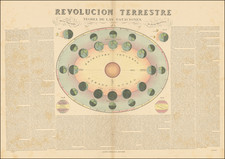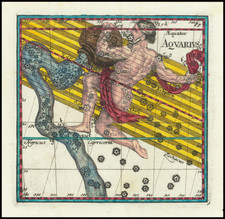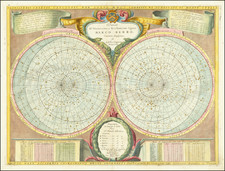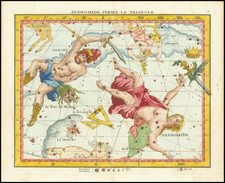An Early Depiction of the First Four Objects Discovered In The Asteroid Belt
Unusual Map of the Planetary System, designed to show the relative distances between the planets and the newly discovered asteroids.
The outermost planet shown is Urano (Uranus).
Between Mars and Jupiter, the Asteroid Belt is shown, including the recently discovered asteroids Pallas (Pallade), Ceres (Cerere), Juno (Giunone) and Vesta.
Asteroid Belt
On January 1, 1801, Giuseppe Piazzi, of Palermo, Sicily, found a tiny moving object in an orbit with exactly the radius predicted by this pattern. He dubbed it "Ceres", after the Roman goddess of the harvest and patron of Sicily. Piazzi initially believed it to be a comet, but its lack of a coma suggested it was a planet.
Fifteen months later, Heinrich Olbers discovered a second object in the same region, Pallas. Unlike the other known planets, Ceres and Pallas remained points of light even under the highest telescope magnifications instead of resolving into discs. Apart from their rapid movement, they appeared indistinguishable from stars.
In 1802, William Herschel suggested they be placed into a separate category, named "asteroids", after the Greek asteroeides, meaning "star-like". Upon completing a series of observations of Ceres and Pallas, he concluded:
Neither the appellation of planets nor that of comets, can with any propriety of language be given to these two stars ... They resemble small stars so much as hardly to be distinguished from them. From this, their asteroidal appearance, if I take my name, and call them Asteroids; reserving for myself, however, the liberty of changing that name, if another, more expressive of their nature, should occur.
By 1807, further investigation revealed two new objects in the region: Juno and Vesta.
Despite Herschel's coinage, for several decades it remained common practice to refer to these objects as planets. and to prefix their names with numbers representing their sequence of discovery: 1 Ceres, 2 Pallas, 3 Juno, 4 Vesta.









![[Hercules, Cygnus, Vultur et Lyra]](https://storage.googleapis.com/raremaps/img/small/91232.jpg)

![Ursa Major [The Big Bear]](https://storage.googleapis.com/raremaps/img/small/67192.jpg)


